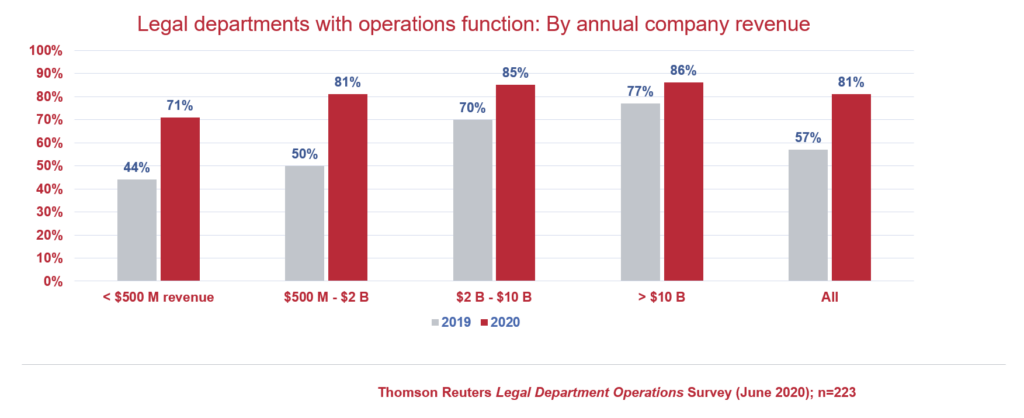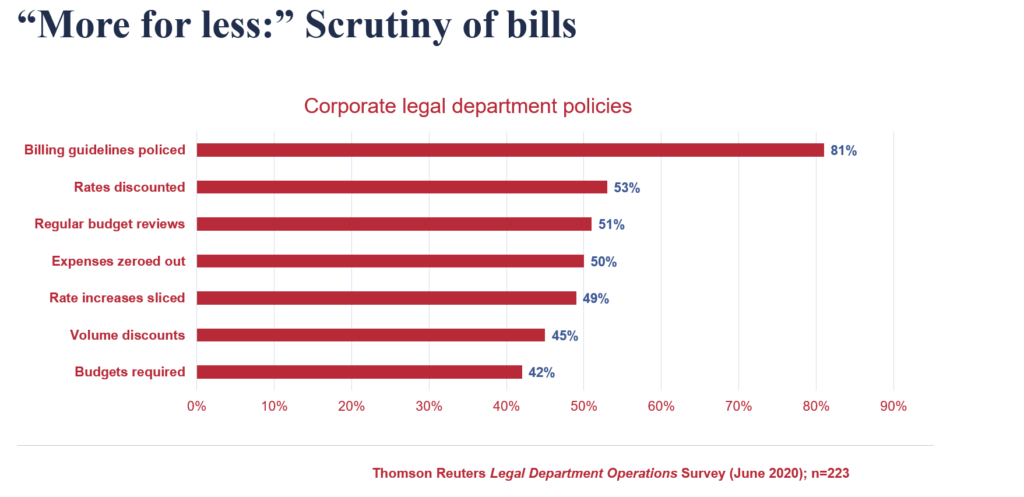Here are just two charts I prepared a few months ago showing the “go-to” tools and practices pinned at 11:
 So: Nearly every type of “billing hygiene” hammer, screwdriver, and wrench is being applied widely; and “legal operations” has gone from being essentially unheard-of to practical market saturation.
So: Nearly every type of “billing hygiene” hammer, screwdriver, and wrench is being applied widely; and “legal operations” has gone from being essentially unheard-of to practical market saturation.
I said at the outset that maroons don’t need to “scale,” and I stand by that, but by no means did I mean to imply or for you to infer that they’re immune from this scale challenge.
We know from first-hand experience that some of the gnarliest and most complicated engagements maroons get–serious and threatening regulatory inquiries (into privacy, anticompetitive practices, data security, corporate [mis]govenance, and more) have changed in scope and complexity over the last decade or so. In the good old days, one company would be targeted by one regulator, usually in the US the DOJ or FTC and in Europe the “Serious Frauds Office” in the UK or one of the many Brussels agencies.
Not so today. In a sort of regulatory one-upsmanship, it’s now the exception that there’s one inquiry from one source. A more typical pattern lately is one US federal agency, something out of Brussels and maybe another European jurisdiction, one or more activist states here (California, New York, Texas). They commonly come up with overlapping, conflicting, and even mutually inconsistent demands on different timelines overseen by players with different constituencies and agendas.
And so far the (rational) response of maroons has been to deploy more $1,000+/hour uber-experts. In general, this is the right approach. But this brings us back to where we came in, with burnout and strained capacity.
We’re running out of running room here; we need to try a different approach.
Some years ago the head of “Google X”–the name at the time for its totally out-there incubator for new projects–described their ambitions with an analogy: “If you tell me to build a car that gets 50 mpg, I can do it with off-the-shelf stuff put together with that express end-goal in mind; if the goal is 500 mpg, I need to forget everything I know and leave it behind me.” (Google X is now named “The X Company,” and they call themselves “the moonshot factory.”)
I’m not going to pretend I have a particular “moonshot” approach in mind (I really really don’t as much as I wish I did), but it’s time to start marshalling some serious brainpower and combinatorial thinking behind this. More Belfasts, Manilas, and Wheelings (labor market arbitrage) and linear development of 2020 technology tools aren’t going to do it.
Tackling this will take, yes, lawyers, but Rule #1 must be they can’t sit at the head of the table: We need process engineers, software developers, business process optimization gurus, pricing Ph.D’s, resource allocation jockeys, and probably half a dozen more “allied professions” in the room.
And one last thing:
Trust.




